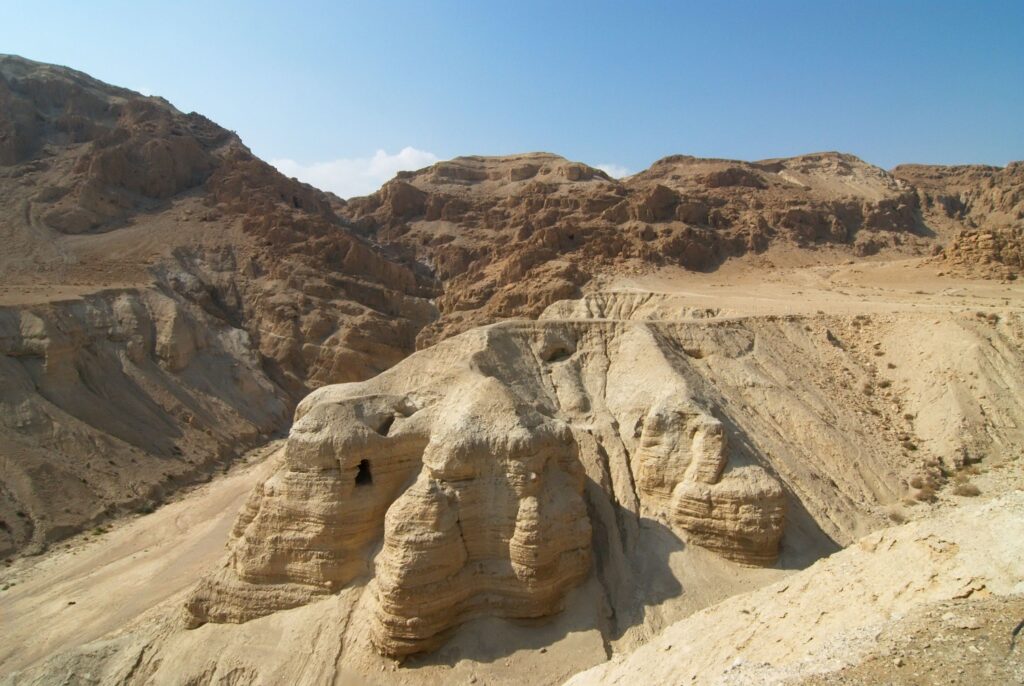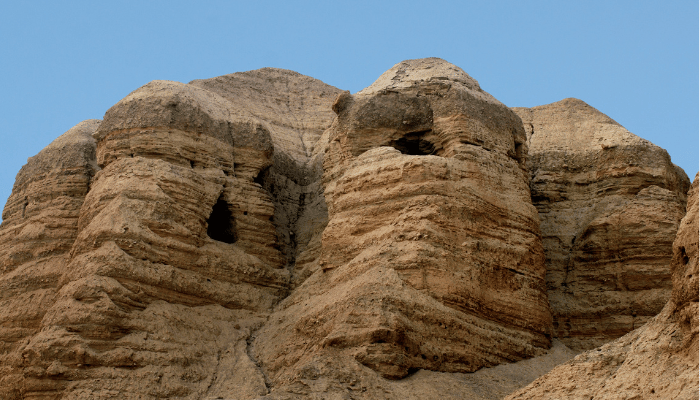Tours in Qumran

On tours in Qumran, step back in time and uncover the secrets of a settlement that once thrived in the Judean Desert. Nestled on the northwestern shore of the Dead Sea, Qumran invites you to explore a fascinating world of ancient ruins and biblical mysteries.
As you enter Qumran National Park, encounter a remarkable collection of archaeological remains. Wander through the ruins and imagine life as it once was for the Essenes, a Jewish sect that settled here over 2,000 years ago.
Admire the intricate water system that sustained the community, including a series of pools and aqueducts. Explore the remains of a communal dining room, a kitchen, a watchtower, and even pottery workshops.
Qumran’s fame extends far beyond its ruins. This site holds a pivotal place in biblical history, as it was here that the Dead Sea Scrolls were discovered.
In 1947, the caves of Qumran, silent for millennia, yielded their secrets, when a young Bedouin shepherd, searching for stray goats, stumbled upon a hidden crevice. Inside, lay clay jars cradling fragile scrolls of leather, their surfaces inscribed with faded Hebrew script. This chance encounter sparked a chain reaction, drawing archaeologists and scholars from across the globe.

The ancient manuscripts, hidden within the caves, offer invaluable insights into Jewish life and thought during the Second Temple period. While the original scrolls are now housed in museums, Qumran provides a unique opportunity to explore the place where they were found. Visit the Cave of the Scrolls and envision the moment of their discovery. Then, head to the visitor center to view fascinating replicas and learn more about their significance.
Qumran’s allure extends beyond its history and archaeology. The surrounding landscape is captivating in its own right. Standing on the plateau, you’ll gaze upon the vast expanse of the Dead Sea, its waters stretching towards the horizon. Then, to the east, the rugged cliffs of the Judean Desert rise dramatically, creating a breathtaking backdrop.
Immerse yourself in the tranquility of this ancient site, while strolling through the ruins. Feel the warmth of the desert sun, and listen to the whispers of the past echoing through the windswept landscape.
Qumran awaits those who seek to uncover the mysteries of the past and experience the beauty of a timeless landscape. Embark on a journey of discovery and let this remarkable site reveal its secrets to you.
Tours in Qumran: Unveiling the Dead Sea Scrolls
Nestled by the Dead Sea’s salty shores, a chance encounter in 1947 led to one of the most significant archaeological finds of the 20th century – the Dead Sea Scrolls. These ancient manuscripts, hidden in caves for over two millennia, revolutionized our understanding of Judaism and the historical context of early Christianity.
A Bedouin’s Treasure: The story begins with a young Bedouin shepherd named Muhammed edh-Dhib. While searching for a lost goat, he stumbled upon a cave near Qumran, a desolate region in the Judean desert. Intrigued by the opening, he threw a stone inside and heard the sound of shattering pottery. This discovery led to the unearthing of several clay jars containing tightly rolled scrolls. Little did he know, he had unearthed a treasure trove of ancient knowledge.
A Race Against Time: News of the scrolls spread quickly, reaching scholars and antiquities dealers alike. Over the next decade, a frantic race ensued to locate and acquire more scrolls. Bedouins sold them on the black market, while archaeologists raced to preserve them. Thankfully, dedicated scholars like Father Roland de Vaux of the École Biblique et Archéologique Française managed to secure a significant number of scrolls for further study.
A Window into the Past: The Dead Sea Scrolls, written on parchment and papyrus, date back to between the 3rd century BCE and the 1st century CE. These manuscripts included biblical texts, commentaries, and non-biblical works that shed light on the beliefs and practices of a Jewish sect, possibly the Essenes. The scrolls notably contained the oldest known copies of portions of the Hebrew Bible, predating previously known versions by over a thousand years.
Rewriting History: The discovery of the Dead Sea Scrolls had a profound impact on our understanding of Judaism and early Christianity. The scrolls revealed a diversity of Jewish thought during the Second Temple period, demonstrating the richness and complexity of religious belief before the rise of Rabbinic Judaism. Additionally, the scrolls provided valuable insights into the social and political climate surrounding the emergence of Christianity.
A Legacy of Discovery
The Dead Sea Scrolls continue to be studied and debated by scholars worldwide. New discoveries and interpretations continue to emerge, offering us a window into a fascinating period in history. The Dead Sea Scrolls stand as a testament to the enduring power of the written word and the enduring human quest for knowledge. Their discovery serves as a reminder that even in the driest of deserts, buried treasures can wait to be unearthed, forever altering our understanding of the past.
Frequently Asked Questions
What is interesting about the Qumran Caves?
Tours in Qumran hold a special kind of intrigue for several reasons:
- The Dead Sea Scrolls: Undoubtedly the most captivating aspect. These meticulously preserved ancient manuscripts, some 2,000 years old, offer a wealth of information about Judaism during the Second Temple period. They include biblical texts, commentaries, and unique documents outlining the beliefs and practices of the Qumran community. Finding these scrolls in the caves near Qumran completely changed our understanding of this era.
- A Window into the Past: Beyond the scrolls, the caves themselves offer clues. Archaeological finds like pottery shards, textiles, and tools provide a glimpse into the daily life of the community. Studying these artifacts helps us understand how they lived, what they ate, and how they functioned in this harsh desert environment.
In essence, tours in Qumran Caves are like a treasure chest, filled with tangible remnants of a bygone era. They offer a unique opportunity to connect with the past, its inhabitants, and their fascinating story.
Can you enter the Qumran caves ?
No, you unfortunately cannot enter the Qumran Caves themselves. There are several reasons for this:
- Preservation: The caves are fragile environments. Foot traffic and exposure to the elements could damage the delicate archaeological features and potentially disturb any undiscovered artifacts.
- Safety: The caves can be unstable and pose a danger to visitors. Many have steep climbs and uneven surfaces.
- Limited Space: The Qumran Caves are quite small, and allowing visitors inside would be impractical and potentially disruptive to ongoing research.
While you can't physically enter the caves, tours in Qumran can still be a fascinating journey back in time.
Visit Qumran on our 7 night Heritage of the Holyland Tour
Or on a 1 day tour to Masada, Qumran & the Dead Sea – from Jerusalem
You can also read about: Tours in Jaffa | Tours in Hula Valley